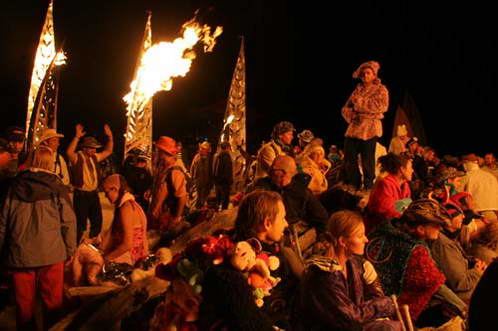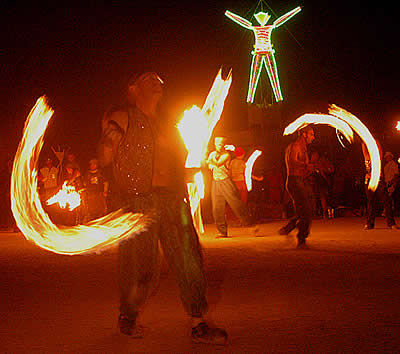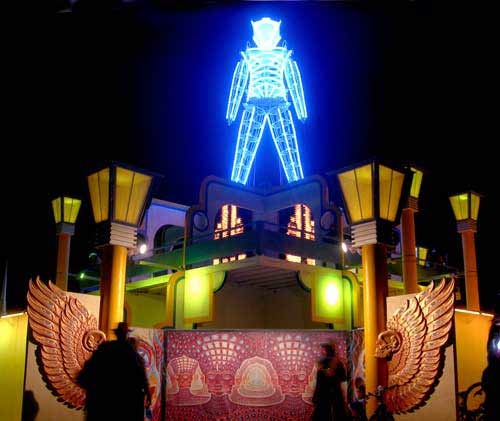How Do I Explain This?
by: Jennifer Warren / Independent Scholar

I met a man at Burning Man late one evening, alone and wandering. We struck up a conversation, and he told me it was his first year at Burning Man. “How do I explain this to people back home?” he asked me, his eyes blazing with awe and frustration. I shook my head helplessly and shrugged my shoulders, sweeping my arm across the horizon. We both stood silently for a long moment, taking in the pulsing cascade of light and sound and people. “You don’t,” I finally said. “You can try, but it’s not like anything else.”
But even so, I will try. Imagine that as far as your eye can see there is nothing green. No plants, no trees, no grass. No bugs, birds, dogs, or cats. There is only a dry alkaline dust rising off a deeply cracked earth. Mountains ring the perimeter, burnt brown and majestic. Winds rise out of nowhere, dust whiting out your vision in all directions for whimsical lengths of time. The sun beats down hot, searing you or warming you depending on it’s mood. Goggles protect your eyes from the dust, a dust mask your lungs. At all times, you keep water with you. And everywhere you look, there are art installations and art cars and art bikes and art camps and artful people. By day, many people hibernate, choosing to sleep through the heat of the afternoon. But by night, the city comes alive, its citizens swathed from head to toe in every conceivable costume, on bike and foot. Colors gleam, lights glow, and sound systems crack open the desert’s silence.

With something as inexplicable and all-encompassing as the Burning Man experience, it would be foolish to think I could sum it up, that I could tell you What It All Means. There are a myriad of meanings out there under the desert sun, each as unique as the individual creating them. What I can do is tell you what Burning Man means to me.
First and foremost, to me Burning Man is a testament to the human spirit of creativity freed from the constraint of commerce. Groups of people create theme camps, providing food, fun, and entertainment to the inhabitants of the city for free. One of my all time favorite Burning Man camp creations was my local neighborhood bar in 2005. A brilliantly colored green and red Moroccan tent rose invitingly from the desert floor. Inside, I found a turn-of-the-century hotel lobby, complete with a antique wooden desk, bookshelves, polished lamps, elegant velvet couches, and vividly colored oriental rugs. A bar ran along the back with a long polished wooden countertop and racks of liquor rose up behind. A DJ off to the left spun dance music and candles glowed along the small tables set up through out the edges of the room.
I had a great time there, dancing and enjoying the sheer improbability of it all. The best part was when I went to leave. A woman looking very official with a clipboard stood at the entrance, blocking me from leaving and telling me that I would have to put my name on the waiting list to leave. She took out a small brush and brushed off the dust from my goggles and smiled at my confusion, repeating her instructions in a polite customer service voice. She laughed with me as I gradually understood the sheer playful absurdity of her request. Of course you would have to put your name on a list to get out of a Moroccan tent in the middle of nowhere with one of the best DJ’s I’d ever heard where the liquor was free and the people were dressed like ghetto fabulous desert mad max survivors. It could only mean one thing: Black Rock City had risen again.
The scale of people creating together is nearly incomprehensible. This year, Burning Man was scheduled to reach 40,000+ residents by Saturday evening, the climax of the event. Just think about that for a second — 40,000 people living in the desert together, creating a city just because they can. There are no advertisers, no sponsors, and no trash collection services. The only thing provided are Portapotties, a gathering place called Center Camp and the surveyed layout of the city itself, with the streets gradually curving in a semi circle around the Playa with the Man in the center. The rest the participants fill in themselves, often at great personal expense and time and effort.

To me, Burning Man beautifully represents the eternal cycle of life and death, creation and destruction. Every year, at the end of the event the city is dismantled and much of the art will be burned. Black Rock City will be built again, but not this Black Rock City. It will come into being only once, and go out in a blaze of glory.
I found myself dancing at 4 a.m. my last evening inside a structure that had been affectionately nicknamed the Waffle, although it’s Belgian creators formally called it Uchronia. Made of thousands of wooden 2x3x30’s, it felt like a desert underwater reef softly lit by green lights disappearing into the black sky. Two European DJ’s were spinning and dancers filled the club. Knowing that this club was going to burn the next day, that this moment would truly never come again had a profound effect on me. It was creation and destruction, inextricably bound as always. But this time, the illusion of permanence was not allowed to take root. We all know that what is born will die. It is the nature of things. But to know when that death will come, by what means, and by whose hand is a rare luxury.
Dancing my last evening away inside a living embodiment of that cycle left me with a sense of peace. I would not be able to go back again. There was only this night and this dance. That was all, no more and no less. By the time I left, tired and dusty and glad to be alive, I knew Burning Man had worked its magic on me once again. And I knew I’d be back next year to help raise the city from the ashes.
Image Credits:
1. Participants at the Angel of the Apocalypse by the Flaming Lotus Girls
2. Fire Conclave performers on the night of the burn
3. Burning Man
Please feel free to comment.
Dear Flow,
This journal entry has nothing to do with television or media. It is a romantic description of Black Rock City, packed with cliches, that has no reason to be on Flow TV. Give this space to a real television theorist.
Questions of relevancy
While I think it is always fair to engage in critique and conversation, I do not think it’s fair to assert that this space need to be given to a “real television theorist.” For one thing, the spectacle of that particular event could easily be considered media/communication; for another thing, that last bit of commentary seems to be a bit of a personal attack on the author, which I think is a bit mean-spirited and runs counter to the spirit of this publication.
Romance and media
While I agree with Adam’s description of Jennifer’s column as romantic description, I disagree with his assessment of her as an illegitimate critic. I especially disagree with his assessment that this column has no place on Flow. First, as one of the editors of this publication, I am especially interested in expanding and examining our definitions of “new media.” The journal was conceived as a space to discuss television AND new media and as Carly points out it is not much of a stretch to see the Burning Man festival as media. Second, much space has been devoted in these web pages to discussion of why columnists love Lost or The Colbert Report. I think pleasure remains one of the key elements in our specific media consumption decisions. Expressions of our joy and pleasure at consuming media that fit our tastes can be very appealing in a criticism saturated environment. We consume, write about, and engage in media because we think it’s important, but also because we like it. I for one am down for a little romance in my media criticism.
I would also like to remind Ms. Warren that she should feel free to respond to comments in this space and to engage in a dialogue about why she thinks this piece fits with Flow’s mission.
Thanks to all of you for reading and commenting.
–Marnie Binfield
Coordinating editor
Appropriateness
I have no problem with romantic media criticism, and its great to have pieces that aren’t just about TV (like Ms. Warren’s piece on Capacitor), but I’ve been over this essay twice and I can’t find any analysis or critique of the event/experience. A fine read, but I’m not sure how it fits in with Flow’s mission. Its not as if you needed another article for this issue, as it is packed with great ones.
Dear Marnie et al,
Your argument that this is an appropriate article for Flow hinges upon the assumption that Burning Man (BM) is unquestionably a media and that felicitous play in this BM/media ecology is enough to warrant the time of Flow readers.
While I agree, having attended BM, that it is sometimes productive for theoretical envisioning to talk of literal space as a confluence of mediations and as traditional places as being replaced by mediascapes. But in an embodied reality, geographic and cultural place continues to exist as a physical, immediate domain of experience distinct in some ways from the issues of Flow.
As a writer for an online column on media, Ms. Warren needed to flesh out how BM is a mediascape and how it is not. What are the distinct qualities that constitute BM as a media environment?
Secondly, she does very little to translate her experiences of “pleasure” into generalities about how the mediascape is produced and negotiated.
Thus, I am happy for Ms. Warren having so much fun at BM but her column fails to contribute to the literature on media communitas, temporary autonomous zones, mediascapes, cultural spaces, deterritorialization, –or even the media art projects, community internet, radio, or film events that proliferate the real BM environment– and the dozen or so other issues which could be constellated in a reflexive, romantic, and theoretical visit to BM.
Indeed, I too agree with you and Ms. Warren that criticism should be personalized, sexualized, and embodied but it should continue from the body to the mind, from the sensual to the universal.
Adam
thanks to Warren
I’m intrigued by the impatient responses and discussion that Warren’s piece provoked. And I’m grateful to her for extending the writing on Flow beyond the discussion of US commercial TV, which is what it tends to focus on. How will we ever re-imagine what “television” could be if we only ever analyze hit series and re-runs? I agree with Fish’s last comment–that it would have been helpful for Warren to discuss how Burning Man functions as a mediascape or how might it reinvent critical definitions of “television” or create new conceptual spaces for media studies. But I hope she’ll continue to challenge us and write beyond the bounds of what Flow readers seem to expect.
Ecstatic Communication
Although the piece above may be perceived a ‘romantic’, due its lack of (a bit done by now) critique of its institutional or political-economic context, or a critical analysis of identity formation, it makes an important contribution to understanding embodied subjectivity in a 3D mediascape that is produced by a dance event like BM.
The experience of such an event is seductive in a Baudrillardian sense: it would stop being a secret if all the components were objectified, while it is almost (!) impossible to analyse the experience anyway, because the event requires complete immersion – there is no space for viewers/spectators, only for participants. The result is an ecstatic comment on an ecstatic event. In contributing to commentaries of affect, this piece is certainly relevant to contemporary cultural and media studies.
http://www.myspace.com/hillegonda
To me, media is first and foremost about the experience of being human, with the creation and communication of art forms to convey and illuminate the human experience. In my Burning Man column, my goal was to convey my experience of a deeply human event. The examples I chose were distilled from countless moments of reality bending juxtapositions to represent the constellation of experience there. To put the ineffable in words is highly challenging; in fact, by definition, it is impossible. But even so, with something as important as Burning Man, I believe it is worth trying.
In an environment as potent and influential as Burning Man’s, there is an unmistakable presence, a palpable sense that something is happening, something that is important, with implications far beyond that desert space or that week in time. It’s not just another party. It’s something else altogether, simultaneously a modern ancient ritual and a futurescape creation, populated by some of the most sophisticated media consumers and creators the world has ever known.
In my desire to express that ineffable sense, I chose to speak from my heart. It was my goal to give presence to something that is easily missed with reason alone. I would agree that I did not “critique” so much as witness. But in that witnessing there was analysis, reflection, and much thought.
In the exploration of new media, I think it is impossible to dismiss the role of the participant. In fact, I think we are in the beginnings of a revolution equal to that engendered by the printing press, radio, and television. It is a revolution of community, technology, and communication. This discussion in Flow is both a representation of that revolution and a celebration of it, as is Burning Man. Again, to me that is why Burning Man was a topic that fit with the stated mission of Flow.
Thank you for your comments. I appreciate each and every one of them, and look forward to incorporating them into my work.
Jennifer
I am producing a fulldome fractal video piece, both educational and entertaining, and I came across this splendid fractal picture of the cracked playa surface. I’m a long-time Burner from New Mexico, and recognized it instantly. I’d like to contact the author/photographer to request permission to use the picture as an example of a natural fractal in my show, with photocredit of course. Thanks!
-Jonathan Wolfe, Ph.D.
Executive Director, Fractal Foundation
New Mexico Regional Burning Man Contact
Perhaps someone could write an essay about the episode of “Malcolm in the Middle” that featured the family’s trip to the Burning Man festival?
Jennifer; have you ever been to smaller gatherings, like Starwood in western NY? We’ve been getting a lot of Burning Man folks there in recent years (maybe because BM has become so popular) trying to bring their special brand of neon desert performance art to what is really a MUCH smaller, earthier gathering in the woods. Still, Starwood’s organizers do emphasize media and technology in a lot of the workshops, rituals and performances…
I haven’t, Peg, but thanks for telling me about them. Seeing BM translate into a woods setting would be fun, albeit a little dangerous with all that fire…;-)